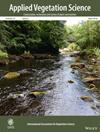Species-group responses improve our understanding of the effects of community dominants on subordinate species along a grazing gradient
Abstract
Questions
Plant communities have been shown to include several functional groups of species that may have contrasting responses to the effects of dominant neighbours, although potentially balancing at the community level. We aimed to assess the potential of species-group vs community-level responses of subordinate species to explain variation in the effects of the dominant shrub Artemisia sieberi on understorey species along a grazing intensity gradient in arid steppes of northeast Iran. We also aimed to assess whether species-group responses help explain variation in community composition.
Locations
An Artemisia steppe community in Golestan National Park (northeast Iran).
Methods
We used the relative interaction index (RII) to quantify the effects of a shrub on the cover of the 12 most frequent subordinate species. We conducted a first principal component analysis (PCA) on species RII followed by cluster analysis to group species depending on their responses to the shrub, and a second PCA on subordinate species composition.
Results
At the community level, subordinate species showed strong competition at the low grazing level, weak facilitation at the intermediate level and weak competition at the high grazing level; a unimodal pattern with a switch back to competition in extremely disturbed conditions that is inconsistent with ecological theories. However, species-group analyses showed contrasting subordinate species responses, supporting either the decrease in competition with increasing disturbance scenario or the collapse of facilitation, but never a switch back to competition as predicted by recent facilitation theory along resource gradients. Moreover, these contrasting species-group responses significantly explained community composition.
Conclusions
Our study provides new evidence, along a grazing intensity gradient, that communities include different species groups with contrasting responses to dominant species.

 求助内容:
求助内容: 应助结果提醒方式:
应助结果提醒方式:


